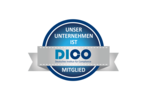
- Internet Corporate
- Contact & Service
- ista Blog
- More than a good intention: how ista will become CO₂-free (net zero)

ista helps its customers to decarbonise their properties. The company has also set itself the target of operating CO₂-free (net zero) by 2030 at the latest. What are the steps that pave the way to this climate goal? Here is an overview.
Eight years can be a short or a long time – depending on the size of the project. The energy-service provider ista has set itself an ambitious goal: the company wants to be completely CO₂-free by 2030 and is therefore tackling one of the most important challenges of our time: climate protection. But is reducing emissions to “net zero” realistic? That all depends on where a company starts from and what actions it implements. Let’s take a closer look:
Where does ista stand on climate protection and what are its plans?
ista has been operating climate-neutral since June 2021. This means: the company plans and realises measures to avoid CO₂ emissions. It offsets the emissions that it has not yet succeeded in avoiding. For example, ista supports certified climate protection projects.
However, if it is to be CO₂-free by 2030, ista must also implement more measures: further cut CO₂ emissions, increase energy efficiency and use renewable energies. Unavoidable emissions will be offset, through reforestation projects, for example. The “net-zero target” will have been achieved when ista takes as much CO₂ equivalent out of the atmosphere as it emits into it.
ista clearly shows how far it has already come along this road and publishes an annual progress report.
What climate protection action is ista taking?
Climate protection thrives on people getting involved. It’s no different at ista. That is why there are clear corporate goals for CO₂ reduction - but the way they are implemented differs from country to country. The following good examples are intended to prompt others to follow suit!
- ista Germany has adopted a "video-first" rule, replacing in-person meetings and dispensing with domestic flights.
- In Belgium, “ista Green” is reducing the amount of rubbish. Without more ado, the team has replaced plastic and cardboard cups with water glasses, coffee mugs and refillable bottles. ista Belgium does not collect the rubbish in plastic sacks but in ecobags; eco-friendly cleaning products are also being used in the offices.
- Saving paper is a never-ending challenge: iSS Poland has already gone largely paperless and aims to process 99 per cent of accounting, administrative and employee documents electronically from this year onwards. Our colleagues in Minsk/Belarus have collected some 400 kilos of paper for recycling and are increasingly using electronic documents.
- ista Spain was able to score points with a change of data centre and save about 50 per cent of the energy previously consumed: that is a difference of 3,504 kWh a year.
What are the next steps in climate protection at ista?
Sustainability and climate protection are a question of attitude at ista. The company continues to measure its carbon footprint in order to evaluate the success of action taken and be able to really operate CO₂-free in 2030. In the coming years, the entire vehicle fleet will be switched to electric cars. Digital alternatives can largely replace business trips. And renewable energies are to cover ista’s entire electricity requirements. The company’s CEO Hagen Lessing put it in a nutshell when he took office in the summer of 2021: "We take our ambitious climate protection targets very seriously, make our progress transparent and will be judged by our actions."






